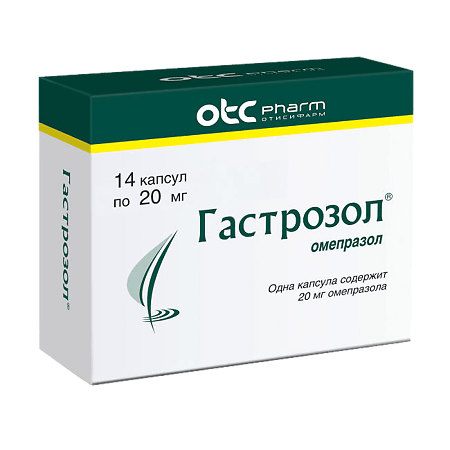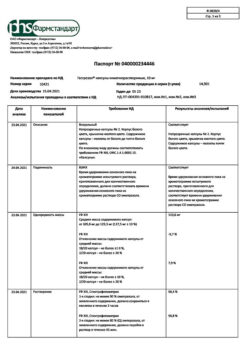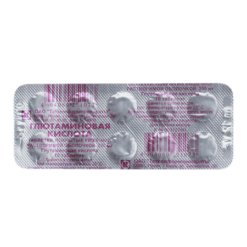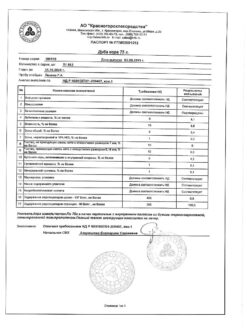No products in the cart.
Gastrozole, 20 mg capsules 14 pcs
€1.00
Out of stock
(E-mail when Stock is available)
Description
Pharmacotherapeutic group: gastric gland secretion reducing agent – proton pump inhibitor
ATX code: A02BC01
Pharmacological properties
Pharmacodynamics
Mechanism of action
Omeprazole is a weak base. It is concentrated in the acidic environment of the secretory tubules of the parietal cells of the gastric mucosa and activates and inhibits proton pump enzyme H+, K+ – ATPase. The effect of omeprazole on the last stage of the process of hydrochloric acid formation in the stomach is dose-dependent and provides highly effective inhibition of basal and stimulated hydrochloric acid secretion regardless of the stimulating factor.
Impact on gastric juice secretion
Omeprazole with daily oral administration provides rapid and effective inhibition of daytime and nighttime hydrochloric acid secretion.
The maximum effect is achieved after 4 days of treatment. In patients with duodenal ulcer omeprazole 20 mg causes steady reduction of 24-hour gastric acidity by at least 80%. This achieves a reduction of the average maximum concentration of hydrochloric acid after pentagastrin stimulation by 70% within 24 hours.
In patients with duodenal ulcer, daily administration of 20 mg of omeprazole maintains intragastric acidity (pH) at ≥3 for 17 hours per day. Inhibition of hydrochloric acid secretion depends on the area under the concentration-time curve (AUC) of omeprazole and not on the plasma concentration of the drug at a given time.
Action on Helicobacter pyloriinvitro
Omeprazole has a bactericidal effect on Helicobacter pyloriinvitro.
Eradication of Helicobacter influenza when using omeprazole with antibacterial agents is associated with rapid resolution of symptoms, a high degree of healing of gastrointestinal mucosal defects and prolonged remission of peptic ulcer disease, which reduces the likelihood of complications such as bleeding as effectively as ongoing supportive therapy.
Other effects associated with inhibition of hydrochloric acid secretion
Patients who take drugs that reduce gastric gland secretion over a long period of time are more likely to have benign gastric cysts that go away on their own with continued therapy. These phenomena are caused by physiological changes as a result of inhibition of hydrochloric acid secretion.
The reduction of gastric hydrochloric acid secretion by proton pump inhibitors or other acid-inhibiting agents leads to an increase of normal gut flora, which in turn may slightly increase the risk of intestinal infections caused by Salmonellaspp. and Campylobacterspp. bacteria, and in hospitalized patients probably also by Clostridium difficile.
At the time of treatment with drugs that decrease gastric gland secretion, serum gastrin concentrations increase. Due to the decrease in hydrochloric acid secretion, the concentration of chromogranin A (CgA) increases.
In children and adult patients on long-term omeprazole, there was an increase in enterochromaffin-like cells, probably related to an increase in serum gastrin concentration. This phenomenon has no clinical significance.
Pharmacokinetics
Distribution
Omeprazole is absorbed in the small intestine, usually within 3-6 hours, time to reach maximum concentration (Tcmax) 0.5-3.5 hours. Bioavailability after a single oral administration is approximately 30-40%, after continuous administration once a day bioavailability increases to 60%. Food intake does not affect the bioavailability of omeprazole.
The binding rate of omeprazole to plasma proteins is about 95% and the volume of distribution is 0.3 l/kg.
Metabolism
It is almost completely metabolized in the liver. The main enzymes involved in the process of metabolism are CYP2C19 and CYP2A4. The resulting metabolites -sulfone and sulfide have no significant effect on hydrochloric acid secretion. It is an inhibitor of CYP2C19 isoenzyme.
Excretion
The elimination half-life is about 40 minutes (30-90 minutes). About 80% is excreted as metabolites by the kidneys and the rest through the intestine.
Special patient groups
No significant changes in bioavailability of omeprazole have been noted in elderly patients or in patients with impaired renal function. In patients with impaired liver function, there is an increase in bioavailability of omeprazole and a significant decrease in plasma clearance.
Indications
Indications
– Duodenal ulcer/p>
– Gastric ulcer
– NSAID associated ulcers and erosions of the stomach and duodenum – eradication of Helicobacter in peptic ulcer disease
/p>
– reflux esophagitis
– symptomatic gastroesophageal reflux disease (GERD)
– dyspepsia associated with hyperacidity
– Zollinger-Ellison syndrome
Children
– gastroesophageal reflux disease in children over 2 years
– duodenal ulcer associated with Helicobacterpylori (as part of combination therapy) in children over 4 years.
Active ingredient
Active ingredient
Composition
Composition
Omeprazole – 235.0 mg (in the form of pellets containing: the active substance: omeprazole – 20.0 mg;
auxiliary substances: Mannitol – 39.95 mg, sucrose – 64.2255 mg, sodium lauryl sulfate – 0.799 mg, sodium hydrophosphate (displaced sodium phosphate) – 2.9845 mg, calcium carbonate – 7.99 mg, lactose monohydrate – 7.99 mg, hypromellose (hydroxypropyl methylcellulose) – 20.5625 mg, metacrylic acid and ethyl acrylate copolymer [1:1] – 58.75 mg, propylene glycol – 1.9035 mg, diethyl phthalate – 5.875 mg, cetyl alcohol – 1.7625 mg, sodium hydroxide – 0.3525 mg, polysorbate-80 (tween-80) – 0.705 mg, povidone (polyvinylpyrrolidone) – 0.611 mg, titanium dioxide – 0.423 mg, talc – 0.141 mg)./p>
Solid gelatin capsules – 63.0 mg: body: titanium dioxide (E 171) – 2.0000%, gelatin – up to 100%; cap: titanium dioxide (E171) – 2.0000%, iron oxide red dye (E 172) – 0.7286%, gelatin – up to 100%.
How to take, the dosage
How to take, the dosage
The drug is taken orally, the capsules are not chewed, usually in the morning, with a small amount of water (immediately before or with a meal).
For patients with difficulty swallowing and for children who cannot swallow the capsule: You should open the capsule and swallow the contents with 100 ml of warm water.
Or mix the contents of the capsule with a sour liquid, such as apple juice or still water. Patients should be advised that the resulting dispersed solution should be taken immediately (within 30 minutes) and stirred immediately prior to consumption.
Adults
Patients with active duodenal ulcer are recommended to take omeprazole 1 capsule (20 mg) once daily. The drug provides rapid relief of symptoms. In most patients, healing of the ulcer occurs within 2 weeks. In those cases where complete healing of the ulcer does not occur within 2 weeks, healing is achieved with a further 2 weeks of taking the drug.
Patients with low-responsiveness duodenal ulcers are usually treated with omeprazole 40 mg (2 capsules) once daily; healing usually occurs within 4 weeks. To prevent recurrence, patients with duodenal ulcer are advised to take omeprazole 20 mg once daily. If necessary, the dose can be increased to 40 mg (2 capsules) once daily.
Peptic ulcer
The recommended dose of omeprazole is 20 mg once daily. It relieves symptoms very quickly. Most patients are cured within 4 weeks. In cases where healing does not occur after the first course of medication, a second 4-week course is usually prescribed during which healing is achieved.
Patients with gastric ulcers of low sensitivity are usually prescribed omeprazole 40 mg (2 capsules) once daily; healing is usually achieved within 8 weeks. A dose of 20 mg once daily is recommended for patients with gastric ulcers to prevent recurrence. If necessary, the dose may be increased to 40 mg once daily.
NNPV-associated gastric ulcers or duodenal erosions
In patients with NSAID-associated gastric or duodenal ulcers or gastroduodenal erosions with discontinued or ongoing NSAID therapy, the recommended dose is omeprazole 20 mg once daily.
The drug provides rapid relief of symptoms, with most patients being cured within 4 weeks. For those patients who have not had a cure during the initial therapy period, healing is usually achieved with repeated 4 week dosing of the drug.
In duodenal ulcers, erosions, and dyspeptic symptoms associated with taking NSAIDs, the recommended dose of the drug is 20 mg once daily.
Helicobacterium eradication regimens for peptic ulcer disease
The three-component treatment regimen:
– omeprazole 20 mg + amoxicillin 1000 mg + clarithromycin 500 mg 2 times daily morning and evening for 7 days;
– omeprazole 20 mg + metronidazole 400 mg (or tinidazole 500 mg) + clarithromycin 250 mg 2 times daily morning and evening for 7 days;
– omeprazole 40 mg (2 capsules) once daily + amoxicillin 500 mg 3 times daily + metronidazole 400 mg 3 times daily for 7 days.
The two-component treatment regimen:
– omeprazole 40-80 mg (2-4 capsules) + amoxicillin 1.5 g daily (dose should be divided in parts) for 2 weeks.
To ensure complete healing, continue treatment as recommended in the duodenal ulcer and peptic ulcer sections.
In cases where the Helicobacterpylori test remains positive after treatment, the treatment may be repeated.
Reflux esophagitis
The recommended dose of omeprazole is 20 mg once daily. The drug provides rapid relief of symptoms, with most patients being cured within 4 weeks. If after the first course of treatment a complete cure is not achieved, a second 4-week course is usually prescribed in which time a cure is achieved.
Patients with severe reflux esophagitis are recommended omeprazole 40 mg (2 capsules) once daily; cure is usually achieved within 8 weeks.
Patients with reflux esophagitis in remission are prescribed omeprazole 20 mg once daily as long-term maintenance therapy. If necessary, the dose can be increased to 40 mg.
Symptomatic gastroesophageal reflux disease
The recommended dose of omeprazole is 20 mg once daily. The drug provides rapid relief of symptoms. If after 4 weeks of treatment (20 mg 1 time per day) the symptoms persist, further investigation is recommended.
Dyspepsia associated with hyperacidity
Omeprazole 20 mg once daily is prescribed to relieve pain and/or a feeling of discomfort in the epigastric region, with or without heartburn. If after 4 weeks of treatment the symptoms do not disappear, further examination of the patient is recommended.
Zollinger-Ellison syndrome
Patients with Zollinger-Ellison syndrome are prescribed the drug in individual dosage. Treatment is continued according to clinical indications for as long as necessary. The recommended starting dose is 60 mg (3 capsules) daily.
In all patients with severe disease and also in those cases when other therapeutic methods did not lead to the desired result, the use of the drug was effective in more than 90% of patients with daily administration of 20-120 mg of the drug. In cases where the daily dose of the drug exceeds 80 mg (4 capsules), the dose should be divided in two and taken in 2 capsules twice daily.
In patients with impaired renal function, no dose adjustment is necessary.
Hepatic impairment
The bioavailability and plasma half-life of omeprazole are increased in patients with impaired hepatic function. In this regard, a dose of 20 mg per day is sufficient.
In elderly patients (aged > 65 years)
Gastroesophageal reflux disease (GERD) in children over 2 years (body weight over 20 kg).
In 20 mg 1 time per day. If necessary, the dose may be increased to 40 mg (2 capsules) once a day. Duration of treatment with reflux esophagitis is 4-8 weeks. The duration of treatment in symptomatic treatment of heartburn and sour belching in GERD is 2-4 weeks. If during 2-4 weeks of omeprazole use symptoms of the disease do not disappear, further examination is recommended.
Duodenal ulcer associated with Helicobacterpylori (as part of combined therapy) in children over 4 years of age (body weight over 31 kg).
In order to eradicate Helicobacterpylori in children older than 4 years with duodenal ulcer disease, combined therapy is carried out taking into account national and regional recommendations regarding bacterial resistance (with use of appropriate antibacterial agents). Omeprazole is indicated by 20 mg 2 times a day.
Treatment duration is 7-14 days.
Interaction
Interaction
The effect of omeprazole on the pharmacokinetics of other drugs Decreased gastric hydrochloric acid secretion during treatment with omeprazole and other proton pump inhibitors may lead to decreased or increased absorption of other drugs whose absorption is dependent on the acid environment.
As with other drugs that inhibit hydrochloric acid secretion or antacids, treatment with omeprazole may lead to decreased absorption of erlotinib, ketoconazole or itraconazole, and increased absorption of digoxin. When concomitant use of omeprazole (at a dose of 20 mg per day) and digoxin there is an increase in digoxin absorption by 10%.
Omeprazole has been shown to interact with some antiretroviral drugs. The mechanisms and clinical significance of these interactions are not always known. An increase in pH on omeprazole therapy may affect the absorption of antiretroviral drugs.
An interaction at the level of CYP2C19 isoenzyme is also possible. When coadministration of omeprazole and some antiretroviral drugs such as atazanavir and nelfinavir during therapy with omeprazole a decrease in their serum concentrations is noted. In this regard, co-administration of omeprazole with antiretrovirals such as atazanavir and nelfinavir is not recommended.
In concomitant use of omeprazole and saquinavir an increase in serum concentration of saquinavir was noted, when used with some other antiretroviral drugs, their concentration was not changed.
Omeprazole inhibits CYP2C19, the main isoenzyme involved in its metabolism. Co-administration of omeprazole with other drugs whose metabolism involves the CYP2C19 isoenzyme, such as diazepam, warfarin (R-warfarin) or other vitamin K antagonists, phenytoin and cilostazol may lead to slower metabolism of these drugs.
Watchful monitoring of patients taking phenytoin and omeprazole is recommended; a reduction in the dose of phenytoin may be required. However, concomitant treatment with omeprazole at a daily dose of 20 mg has no effect on plasma concentrations of phenytoin in patients taking the drug for a long time.
When using omeprazole in patients receiving warfarin or other vitamin K antagonists, international normalized ratio monitoring is necessary; in some cases, it may be necessary to decrease the dose of warfarin or other vitamin K antagonist.
In contrast, concomitant treatment with omeprazole at a daily dose of 20 mg does not alter the coagulation time in patients on long-term warfarin.
The use of omeprazole in a dose of 40 mg once daily led to an increase in Cmax and AUC of cilostazol by 18% and 26%, respectively; for one of the active metabolites of cilostazol, the increase was 29% and 69%, respectively.
. Pharmacokinetic/pharmacodynamic interaction between clopidogrel (loading dose of 300 mg and maintenance dose of 75 mg/day) and omeprazole (80 mg/day orally) was observed, resulting in an average 46% decrease in exposure to the active metabolite clopidogrel and an average 16% decrease in maximal inhibition of ADP-induced platelet aggregation.
The clinical significance of this interaction is unclear. An increased risk of cardiovascular complications with clopidogrel and proton pump inhibitors, including omeprazole, has not been shown in randomized clinical trials.
The results of several observational studies are inconsistent and do not provide a definitive answer about the presence or absence of an increased risk of thromboembolic cardiovascular complications with clopidogrel and proton pump inhibitors.
Omeprazole does not affect the metabolism of drugs metabolized by CYP3A4 isoenzyme, such as cyclosporine, estradiol, budesonide, quinidine, lidocaine.
No interaction of omeprazole with the following drugs was found: antacids, theophylline, caffeine, propranololol, ethanol, S-warfarin, piroxicam, diclofenac, naproxen, metoprolol.
Concomitant use of omeprazole and tacrolimus resulted in increased serum concentrations of tacrolimus.
In some patients, a slight increase in plasma concentrations of methotrexate has been reported with concomitant use of proton pump inhibitors. When using high doses of methotrexate, omeprazole should be temporarily discontinued.
The effect of drugs on pharmacokinetics of omeprazole
The CYP2C19 and CYP3A4 isoenzymes are involved in metabolism of omeprazole. Concomitant use of omeprazole and inhibitors of CYP2C19 and CYP3A4 isoenzymes, such as clarithromycin, erythromycin and voriconazole, may increase plasma concentrations of omeprazole due to delayed metabolism of omeprazole.
The co-administration of omeprazole and voriconazole leads to more than a twofold increase in the AUC of omeprazole. Due to good tolerability of high doses of omeprazole, no dose adjustment of omeprazole is required with short-term concomitant use of these drugs.
Drugs inducing CYP2C19 and CYP3A4 isoenzymes, such as rifampicin and preparations of St. John’s wort, when used together with omeprazole may decrease its plasma concentration due to accelerated metabolism of the drug.
Special Instructions
Special Instructions
In the presence of any worrisome symptoms (e.g., significant spontaneous weight loss, recurrent vomiting, dysphagia, bloody vomiting, or melena) and the presence of a peptic ulcer (or suspected peptic ulcer), malignancy should be excluded, because treatment with omeprazole, by masking symptoms, may delay a correct diagnosis.
The co-administration of omeprazole with drugs such as atazanavir and nelfinavir is not recommended.
Studies have noted a pharmacokinetic/pharmacodynamic interaction between clopidogrel (loading dose of 300 mg and maintenance dose of 75 mg/day) and omeprazole (80 mg/day orally), which results in an average 46% decrease in exposure to the active metabolite clopidogrel and an average 16% decrease in maximal inhibition of ADP-induced platelet aggregation.
Therefore, concomitant use of omeprazole and clopidogrel should be avoided (see section “Interaction with other medicinal products”).
Particular observational studies suggest that therapy with proton pump inhibitors may slightly increase the risk of osteoporosis-related fractures, but other such studies have not shown an increased risk.
In randomized, double-blind, controlled clinical trials of omeprazole and esomeprazole, including two open-label studies with more than 12 years of therapy, the association of osteoporosis-related fractures with proton pump inhibitors has not been confirmed.
While a causal relationship between omeprazole/esomeprazole use and osteoporotic fractures has not been established, patients at risk for osteoporosis or osteoporotic fracture should be appropriately monitored clinically.
Chromogranin A (CgA) concentrations are increased due to decreased hydrochloric acid secretion. Increased concentration of CgA may affect the results of examinations to detect neuroendocrine tumors. To prevent this effect, omeprazole should be temporarily discontinued 5 days before the CgA study.
Impact on the ability to drive vehicles, mechanisms
There are no data on the effect of the drug on the ability to drive vehicles or other mechanisms. However, due to the fact that during the therapy dizziness, blurred vision and somnolence may occur, caution should be exercised while driving motor transport or operating machinery requiring high concentration and quick psychomotor reactions.
Contraindications
Contraindications
Hypersensitivity to omeprazole, substituted benzimidazoles or other in-gredients in the drug;
Lactase, sucrose/isomaltase deficiency, lactose intolerance, fructose intolerance, glucose-galactose malabsorption;
Co-use with erlotinib, posaconazole, clarithromycin (in patients with hepatic impairment), St John’s wort;
breastfeeding period;
– gastroesophageal reflux disease
-childhood under 2 years of age and body weight under 20 kg;
– duodenal ulcer associated with Helicobacterpylori
-children under 4 years of age and body weight less than 31 kg.
With caution
Osteoporosis, significant spontaneous weight loss, frequent vomiting, dysphagia, vomiting blood or melena, and in the presence of peptic ulcer (or suspected peptic ulcer), pregnancy. The presence of a malignancy should be ruled out, as treatment may mask symptoms and thus delay diagnosis.
Side effects
Side effects
The following are adverse effects independent of the dosing regimen of omeprazole that have been observed in clinical trials as well as in post-marketing use. The adverse events noted with omeprazole listed below are graded according to the following frequency of occurrence: Very common (> 1/10), common (> 1/100 to < 1/10), infrequent (> 1/1000 to <1/100), rare (> 1/10000 to < 1/1000), very rare (< 1/10000), unspecified frequency (cannot be calculated from available data).
Digestive system disorders: frequently – diarrhea, constipation, abdominal pain, nausea, vomiting, flatulence; rarely – dry mouth, stomatitis, gastrointestinal candidiasis, microscopic colitis.
Hepatic and biliary tract disorders: infrequent – increase in the activity of “liver” enzymes; rare – hepatitis (with or without jaundice), liver failure, encephalopathy in patients with liver disease.
Hematopoietic organs: rarely – leukopenia, thrombocytopenia, agranulocytosis, pancytopenia, hypochromic microcytic anemia in children.
Nervous system disorders: frequently – headache; infrequently – vertigo, paresthesia, somnolence; rarely – taste disorders.
Musculoskeletal system: infrequent fractures of the hip, carpal and vertebral bones; rarely – arthralgia, myalgia, muscle weakness.
Skin and subcutaneous tissue: infrequent dermatitis, rash, pruritus, urticaria; rarely alopecia, photosensitization, erythema multiforme, Stevens-Johnson syndrome, toxic epidermal necrolysis.
Immune system disorders: rare – hypersensitivity reactions (e.g., angioedema, fever, anaphylactic reaction/anaphylactic shock).
Metabolism and nutrition: rare – hyponatremia; very rare – hypocalcemia due to severe hypomagnesemia, hypokalemia due to hypomagnesemia; unspecified frequency – hypomagnesemia.
Psychiatric disorders: infrequent – insomnia; rare – agitation, aggression, confusion, hallucinations, depression.
An organ of vision: rarely – blurred vision.
Respiratory system, chest and mediastinum: rarely – bronchospasm.
Renal and urinary tract: rarely – interstitial nephritis.
Gender and mammary glands: rarely – gynecomastia.
General disorders and disorders at the site of administration: infrequent – malaise; rarely – sweating, peripheral edema.
Cases of glandular cysts in the stomach have been reported in patients taking drugs that reduce gastric gland secretion over a long period of time; they pass on their own with continuation of therapy.
Overdose
Overdose
Single oral doses of omeprazole up to 400 mg (20 capsules) did not cause any severe symptoms. Single doses of omeprazole up to 560 mg in adults caused symptoms of moderate intoxication. The elimination rate of the drug did not change with increasing doses, and no specific treatment was required.
Symptoms: dizziness, confusion, apathy, headache, vascular dilatation, nausea, vomiting, tachycardia, flatulence, diarrhea.
Treatment: symptomatic, if necessary gastric lavage, prescription of activated charcoal.
Pregnancy use
Pregnancy use
Pregnancy
Researches have shown no adverse effects of omeprazole on the health of pregnant women or on the fetus or the newborn baby. Omeprazole can be used during pregnancy.
Breastfeeding
Omeprazole passes into breast milk; use of omeprazole during breastfeeding is contraindicated.
Similarities
Similarities
Additional information
| Shelf life | 3 years |
|---|---|
| Conditions of storage | In a dry, light-protected place at a temperature not exceeding 25 °C |
| Manufacturer | Pharmstandard-Leksredstva, Russia |
| Medication form | capsules |
| Brand | Pharmstandard-Leksredstva |
Other forms…
Related products
Buy Gastrozole, 20 mg capsules 14 pcs with delivery to USA, UK, Europe and over 120 other countries.













